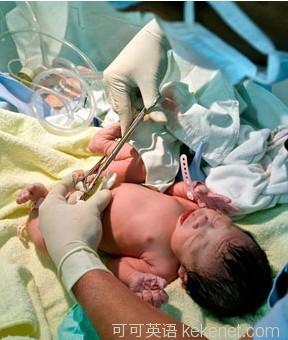
Science and Technolgy
科技
infantile anaemia
嬰兒貧血
Blood simple
簡單的輸血
A small change in how babies are delivered might abolish infantile anaemia
分娩方式的簡單改變可能幫助消滅嬰兒貧血
CHILDHOOD anaemia is a problem. Around the world, almost a quarter of under-fives suffer from it. And anaemia is not a trivial thing. A child's development, both physical and mental, is stifled by a lack of iron. The reason is that, besides its well-known role in haemoglobin, the oxygen-transporting molecule in the blood, iron is also involved in many aspects of brain development.
兒童貧血癥是一個全球性的問題,將近四分之一的五歲以下兒童忍受著該病的折磨,使得我們無法忽視它。兒童身體和智力的發育,都會受到鐵元素匱乏的影響,因為除了在血液中的氧氣運輸分子——血紅蛋白中發揮著眾所周知的作用外,鐵元素還在許多方面參與了大腦的發育。
A study just published in the British Medical Journal by Ola Andersson, an obstetrician at the Hospital of Halland in Halmstad, Sweden, suggests that a simple change of medical procedure when a child is born may bring a big reduction in anaemia. That change is not to cut the umbilical cord linking the child with the placenta straight after birth—as is standard practice—but, rather, to give it time to transfer more of the placenta's contents (particularly its blood) to the child it has been nurturing.
來自瑞典哈爾姆斯塔德市哈蘭醫院的產科醫生Ola Andersson剛剛在不列顛醫學雜志上發表的一項研究表明,簡單改變嬰兒分娩的流程,也許就能顯著降低貧血癥的發生。這個改變是,不要像慣常操作那樣,在胎兒出生后馬上剪斷連接胎兒與胎盤的臍帶,而是等一等,讓更多胎盤中的物質(特別是血液)流向胎兒。
The argument in favour of rapid clamping is that too much blood may flow from the detached placenta to the newly born child, and that this can cause problems of its own. But that is unproven, and would be a strike against evolution because, in nature, the umbilicus of a mammal usually does remain attached to the infant for some time after birth. Only the modern technology of clamps and sharp scissors permits the slithery tube to be dealt with at speed.
堅持快速鉗住臍帶(速鉗法)的觀點認為,讓太多的血液從胎盤流向新生兒會帶來其自身的問題,但這種觀點其實從未被證實,而且顯然與進化論相抵觸,因為在自然界中,哺乳動物的胎兒通常在出生后一段時間內仍然通過臍帶與母體相連,只有鉗子和剪子這種現代工具,才能迅速地處理光滑的臍帶。
To test her idea that extended post partum connection to the placenta is good for a child's health, Dr Andersson and her colleagues recruited 334 pregnant, non-smoking women whose fetuses appeared to be healthy. When these women came to term, their midwives followed one of two sets of instructions, chosen at random and given to them just before each birth. In 166 cases the newborns had their umbilical cords clamped within ten seconds of delivery. The other 168 had them clamped after at least three minutes had passed.
為了證實延長產后胎兒與胎盤的連接時間確實有益于兒童的健康,Andersson博士和她的同事們招募了334個沒有吸煙習慣的孕婦志愿者,她們肚中的胎兒看起來都很健康。在孕婦們臨產時,助產士為她們從兩種生產方式中隨機選擇一種。在166例中,臍帶在新生兒出生后的十秒內被鉗住,而在另一組168例中,這個時間至少超過三分鐘。
When the children were four months old, Dr Andersson re-examined them and took a blood sample. Those babies whose umbilical clamps had been applied after three minutes had, on average, iron levels 45% higher than those whose cords had been clamped immediately. Put another way, only 0.6% of them were anaemic, compared with 5.7% of the rapidly clamped.
在這些兒童四個月時,Andersson博士重新對他們進行檢查并抽取血樣。那些臍帶在三分鐘后才被鉗住的兒童,體內的鐵元素平均水平要比采用速鉗法的兒童高出45%。從另一個角度看,相較于采用速鉗法的兒童中5.7%的貧血癥發生率,他們的這個比例只有0.6%。
Rapid clamping of the umbilicus, then, seems to cause one child in 20 to become anaemic, at least in the early months of its life. Any experiment of this sort needs to be repeated, of course, to check it is correct. But if it is, then the burden of proof in the matter of when to cut the cord will have shifted from those who would cut late to those who would cut early. The cost of doing so would seem negligible; the benefit, great.
看起來速鉗法在每20個兒童中便導致一例在其出生后的最初幾個月內發生貧血。當然,這類研究結果都需要通過重復實驗來驗證可靠性。但如果這個結論確實正確,那么采用速鉗法的人將更有義務來證明為什么要迅速的剪斷臍帶,畢竟延長幾分鐘時間沒有什么麻煩,而益處卻是顯而易見的。











